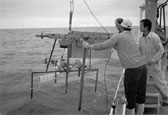


A Consortium Approach to Marine Science
Introduction
The Origins of VIMS and Its Consortium Approach
Benefits and Problems of a Consortium Approach
Realizing the Benefits, Overcoming the Problems
VIMS' Role in the Consortium
Building on the Consortium Approach
Conclusion
References
Index
Search
Help
Contact us

As part of its contribution to its partners, VIMS also operates a small Supplementary Grants Scheme for postgraduate student research, which provides about $10,000 each year to a very sensitive and responsive part of the university research body, and has a disproportionately large value, relative to the sum of money.
These kinds of activities are the essential 'glue', the matrix which binds a consortium. Recognizing this provides a clear answer to the implicit question—if the consortium approach is so successful, why is it not more in evidence elsewhere? Or, in other words, what actually makes a consortium work, apart from a strong measure of goodwill and a dose of deft management. The answer is that, in this consortium, there is a brokering member; one which does not have an agenda in competition with those of other members, and which acknowledges the role as valuable in its own right.
The situation may be contrasted with that in, for example, the Australian Marine Sciences Consortium (AMSC), a body formally constituted in 1986, with a membership comprising mainly various Australian universities, along with several government authorities. (Until recently, the Victorian universities have not been involved, but now have a membership represented by VIMS, in recognition of our regional consortium activities.) Although AMSC has different objectives from those of the VIMS consortium, a comparison is nonetheless useful. The track record of the AMSC is modest, and its level of activity is not high, despite some obvious requirements for action. I suggest the reasons lie in the fact that, without a brokering member acting as a consistent driving force, it is difficult to overcome the problems inherent in the consortium approach and to realize the potential benefits.

Organisations in Australian Science at Work - Victorian Institute of Marine Sciences
 |
Royal Society of Victoria |  |
© Copyright of Australian Science and Technology Heritage Centre and The Royal Society of Victoria 2001
Published by Australian Science and Technology Heritage Centre, using the Web Academic Resource Publisher
http://www.austehc.unimelb.edu.au/smv/084.html